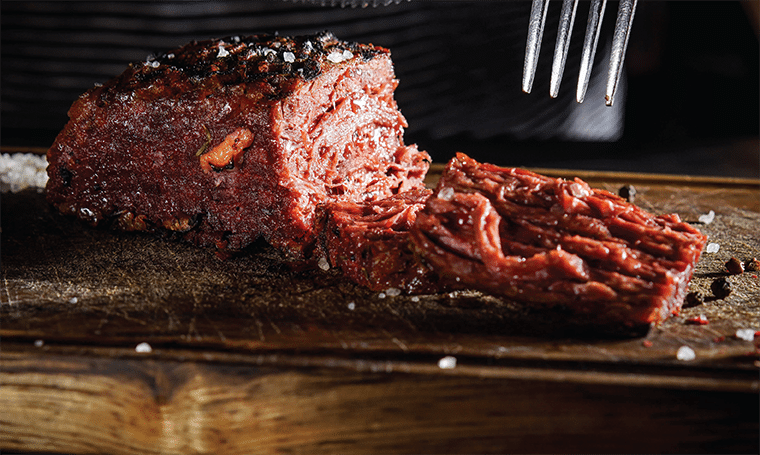As part of our Veganuary feature That's Food and Drink is bringing you news about vegan foods that you can try at home or in your pub or restaurant.
We are launching the feature with products from the Redefine Meat range from steaks to bratwurst sausages.
Redefine Flank Steak, 200g, RRP £7.962025 Great Taste Awards (One Star)
The world’s first plant-based steak, originally designed to be enjoyed in restaurants. Now available for home chefs as well as professional caterers.
This delicious, unmistakably meaty whole cut of New-Meat™ is suitable for grilling, pan-frying or roasting.
Ideal for plant-based steak nights, hearty Sunday roasts, or as the centrepiece of a vegan Christmas dinner.
Chef’s Tip: Cook over medium heat, then baste with garlic and rosemary to create the vegan steak of your dreams.
Redefine Lamb Kofta Mix, 250g, RRP £3.97
2025 Great Taste Awards (Two Stars)
Seasoned to perfection, Redefine Meat’s Lamb Kofta Mix is a tasty, versatile option to shape as you choose. Transform into rich and flavourful kebabs, curries, or even shepherd’s pie.
Chef’s tip: Use Redefine Lamb Kofta Mix as the filling for the ultimate vegetarian sausage roll! Mix in freshly chopped herbs and onions to take it to the next level.
Redefine Pulled Beef, 200g, RRP £4.47
2024 Great Taste Awards (One Star)
Captures the mouthwatering flavour and slow-cooked texture of pulled beef. Suitable for a wide range of dishes from tacos and ragus to stir-fries and sandwiches.
Chef’s tip: Deliciously versatile and ready in minutes – use in any dish that calls for the deep flavour and texture of slow-cooked beef, from Beef & Ale Pie to Beef Rendang or your favourite Asian stir-fry.
Redefine Premium Burgers, 240g, RRP £3.97
2025 Tasty Award Winner, 2024 Great Taste Awards (Two Stars)
These succulent patties are the perfect foundation for barbecues and burger nights. Pile high with all your favourite additions – from lettuce and tomato to bacon and burger sauce.
Chef’s tip: Coarsely ground and designed to cut pink in the middle. For best results, cook straight from frozen, allow a golden crust to form, and finish with your signature burger toppings.
Redefine Pulled Pork, 200g, RRP £4.47
Experience the unmistakable flavour and texture of a pub-grub classic. Combine with your favourite sauce for mouth-watering sandwiches, quesadillas, and much more.
Chef’s tip: High in protein and low in fat, Redefine Pulled Pork is just as at home in a nourishing protein bowl as it is in an indulgent pulled-pork bun – or as your new favourite addition to taco night.
Redefine Beef Mince, 250g, RRP £3.97
The perfect foundation for family favourites like spaghetti Bolognese, meatballs, and lasagne, Redefine Beef Mince is a versatile and delicious freezer staple.
Chef’s tip: Shape into balls and smash into a hot pan for the ultimate plant-based smash burgers.
Redefine Shawarma, 200g, RRP £3.97
This rich, authentic New-Meat™ Shawarma captures the essence of Mediterranean with a juicy slow-cooked texture – ideal for prepping lunchtime wraps and bowls.
Chef’s tip: Pile onto a platter with couscous for a Middle Eastern feast or wrap in flatbread and foil for an on-the-go lunch. Simply fry in a pan or roast in the oven for a quick and easy meal solution.
Redefine Bratwurst 2x 100g £4.00.
A plump, delicious and juicy sausage, following the tradition of classic pork flavored delicacies. Perfect for grilling or frying in a pan, this hearty, juicy, plant-based sausage is sure to satisfy even carnivores.
Chef's tip: Redefine Bratwurst allows meat lovers, vegetarians and vegans to enjoy a great meat-eating experience without compromising on taste.
Redefine Meat Ltd. products are plant-based, made with non-GMO ingredients and do not contain any animal-based ingredients or by-products.
Available from Ocado https://www.ocado.com
You can learn more here https://www.redefinemeat.com
























